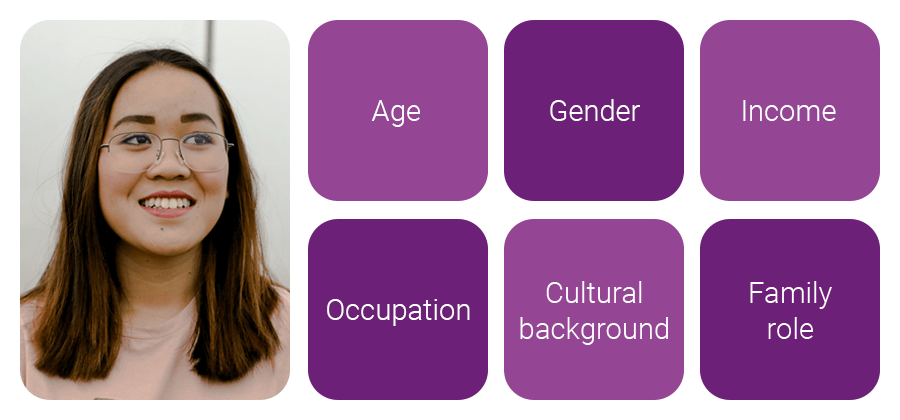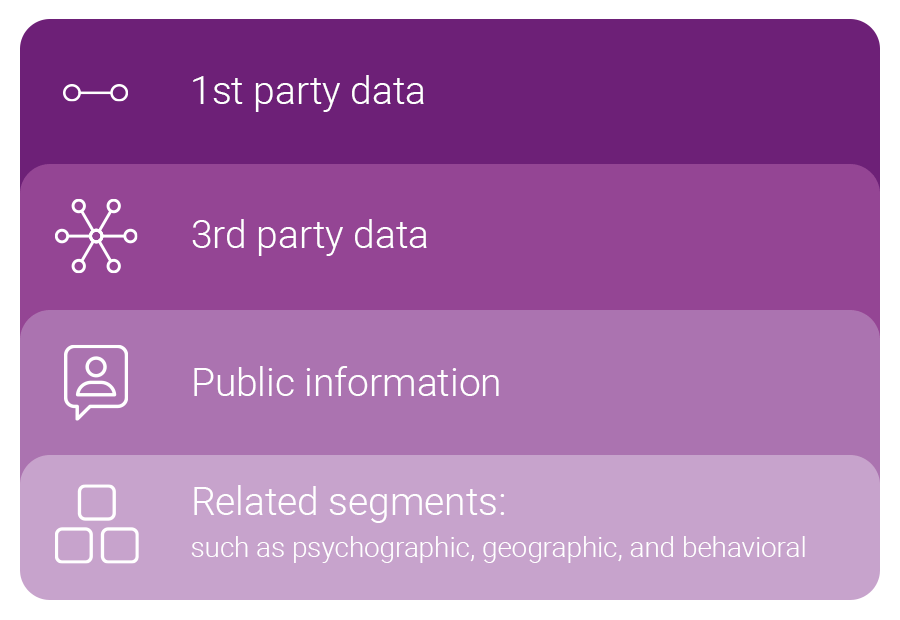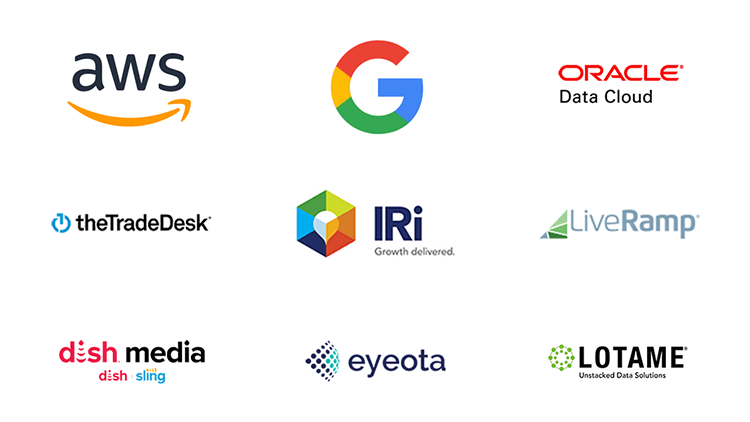Demographic segmentation overview
What factors play a role in demographic segmentation?
Demographic segmentation in marketing is a type of consumer segmentation that involves grouping consumers based on shared demographic characteristics to create better marketing campaigns. These characteristics include age, gender, income, occupation, marital status, family size, and nationality. It’s one of the most used segmentation methods because collecting data through consumer insights, analytics, and census data is easy. In addition, many marketers consider it the most cost-effective method of segmenting the market.
Businesses can use their resources more effectively by segmenting the market into smaller groups with shared characteristics. As a result, they can determine which messages will relate best to audience members based on what they have in common.
The most popular characteristics used in demographic segmentation are age, gender, income, occupation, cultural background, and family role. Here’s a look at each and how appealing to these groups can help your marketing campaign.

Marketers use age segmentation to target specific age groups. They view this characteristic as a particular age range or certain life stages, such as infants, children, teens, young adults, middle-aged, and seniors. Age segmentation can also be based on generations like Baby Boomers, Generation X, Millennials, Gen Z, etc. Because people in these generation groups were born around the same time, they grew up with shared experiences and usually share some of the same buying behaviors.
Age groups have their own spending habits, and they also respond differently to advertisements. Certain age groups often speak differently than other groups and use different platforms. For instance, older generations are more likely to engage with mail or email advertisements, compared to millennials who spend more time on social media.
Gender-specific marketing is a great technique when done well as the different genders have distinct likes, thoughts, and preference. However, when using gender-based segmentation, like other types of segmentation, it is crucial for marketers to avoid delivering marketing messages based on stereotypes. These types of advertisements can turn off or even anger your target market.
Knowing the income range of your consumers can help you target the right audience for your product.
Demographics are often considered when manufacturers determine pricing strategies. Consumers with lower incomes are usually more likely to purchase items that have the best deal and will choose inexpensive products. Manufacturers targeting the masses or manufacturing everyday items will more likely appeal to these people. On the other hand, people with higher incomes may prefer luxury products. Thus, luxury item manufacturers will target high-income consumers and set prices accordingly.
Occupation targeting is useful when creating products for specific job positions or industries. Dividing the market based on job title or seniority is helpful when determining who your products can benefit. An example of this demographic segmentation would be a company that makes suits targeting people working in high-end business positions. In contrast, other clothing companies may have products better suited for casual work environments and target consumers working in less formal environments.
Many B2B companies also use occupation segmentation to appeal to professionals who can make purchase decisions for their organization.
Demographic segmentation can also involve creating groups based on different cultures that have distinctive interests, beliefs, and attitudes. These differences affect the marketing strategies that attract customers, as they can impact their buying decisions and how they respond to advertisements
It’s essential to consider the family makeup when creating segments, such as marital status, family structure, and family life stages. Single people often prioritize themselves, while couples prioritize each other. A couple who just had their first child will have different needs from those with multiple kids. Couples without children may not be interested in low-cost household items like large families are.
Marketers should also pay attention to changing family dynamics because these changes bring changes in the family’s needs and desires, significantly affecting their spending habits.
Demographic segmentation is used to target specific audiences based on shared characteristics. Using this information, you can create ads that relate to your audience. Here’s why that matters.
Demographic segmentation helps companies learn more about their customers’ needs and preferences to create marketing strategies that appeal to them. As a result, consumers feel they can identify with your brand, improving the customer experience and building brand loyalty.
Segmenting the market by demographics helps you present marketing messages differently to each segment. An example is dividing the market based on family size to sell a car. You can market the vehicle as family-friendly to parents but market the same car as suitable for long drives for those without kids. Thanks to demographic segmentation, you can use the right messaging for the right audience.
Demographic segmentation gives you precise information about consumers to create advertising campaigns and marketing messages that directly relate to your audience. That means spending your money on prospects who are most likely to become customers instead of spending money on mass audiences. You won’t be wasting money on broad advertising that reaches people who aren’t interested in your company.
You can also effectively communicate your company’s values to customers with demographic segmentation. By knowing what your audience wants, you can spend your money more wisely creating ads that will turn prospects into customers.
You can better understand your customers and create personalized marketing campaigns with demographic segmentation. Personalized strategies lead to better customer satisfaction, retention, and loyalty. The more you understand your audience, the more likely they are to feel like your products were made specifically for them, which will keep them coming back.
You may already have some demographic data before you begin segmenting your audience. However, if you don’t have enough information, you can gather demographic data directly from consumers, third-party sites, or public records. Experian can help you enrich your data to identify and understand your target audience.

First-party data is information you gather directly from your customers, such as their name, date of birth, and address. One way to collect demographic data about your customers is through surveys. These are often included at the end of surveys sent out for other reasons, like post-purchase surveys or customer service call follow-ups. At the end of these surveys, you may ask customers to provide information like their age or family dynamic.
We can help you enrich your first-party data to build a unified view of your consumers. Experian can conduct data matching services in our privacy-safe environment to join data sets that power collaboration in the ecosystem.
Another great way to collect data for demographic segmentation is through third-party services like browser cookies, mobile apps, or online platforms. These sources can give you a clearer picture of your audience. As cookie deprecation looms, marketers are using cookieless identifiers, like Hashed Email, to help gather consumer data.
A lot of demographic information is easy to collect through public resources. Many countries and international committees have publicly available demographic resources such as governmental and academic information.
Other popular types of consumer segmentation include psychographics, geographics, and behavior. These can be used with demographic segmentation to create more targeted marketing campaigns.
Psychographic segmentation involves grouping people together based on shared psychological aspects. These include values, opinions, personality traits, and interests. This data helps businesses focus on prospects with certain lifestyles. Demographic and psychographic segmentation overlap because many people with shared demographics also have similar opinions and interests. By using both segmentation methods, companies can look at factors that motivate customers to make buying decisions.
Geographic segmentation is segmentation based on location. It can be based on city, state, or country, but it can also be based on time zones, language, and population types like urban, suburban, and rural.
Geographic segmentation is often a subset of demographic segmentation because of its many shared traits. For instance, family dynamics are similar among those who live in suburban areas vs. those who live in rural areas. Using both geographic and demographic segmentation, you can create marketing campaigns that appeal to the families most likely to use your products.
Behavioral segmentation involves dividing your audience into groups based on shared behaviors like decision-making processes, previous purchasing behavior, and consumption. Behavior and demographic segmentation often go together because people of the same demographics often have shared behaviors. For example, many young adults are turning toward more sustainable products while older generations are sticking to products they’ve used for decades.
Using demographic segmentation in your marketing campaigns is an excellent way to engage your audience with relevant messages and increase conversion rates. Understanding your company’s demographic segments and utilizing these segments to your advantage is the key to genuine connection.
Our consumer segmentation tool can help you target specific audiences to create personalized campaigns. Resulting in more conversions, higher customer retention, and better relationships.
Contact us to learn more about how we can make your customer relationships more meaningful and take your business to the next level.
We can help you create marketing strategies catered to the specific preferences and behaviors of your current and prospective customers. We specialize in helping brands discover data-driven insights to make an everlasting impact on consumers.
Our data and identity products and services can help you learn more about customers and target audiences, leverage data resources, improve targeted marketing, create personalized campaigns, and optimize marketing strategies.
With us, you’ll understand your consumers better, make more effective data-informed decisions, and increase your customer base for bigger revenue.

This site is protected by reCAPTCHA and the Google Privacy Policy and Terms of Service apply.